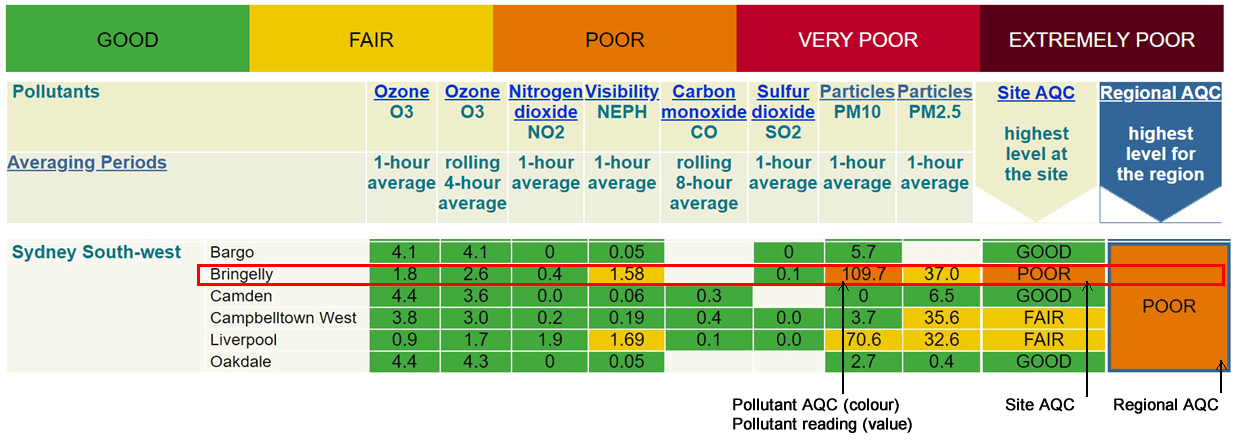Air quality categories (AQC) are colour indicators used to summarise air quality measurements. In New South Wales, 5 colour indicators are used to classify air quality as 'Good', 'Fair', 'Poor', 'Very Poor' or 'Extremely Poor'.
The AQC is determined by measurements of key air pollutants we monitor at our monitoring locations:
- particles less than 2.5 micrometres diameter (PM2.5)
- particles less than 10 micrometres diameter (PM10)
- ozone
- nitrogen dioxide
- carbon monoxide
- sulfur dioxide
- visibility.
The AQC is reported for each station, and for each region comprising the New South Wales Air Quality Monitoring Network. Details on how monitoring data are used to derive the AQC are in the tab below.
What the air quality categories mean for you
The AQC colours provide at-a-glance information to help people plan their activities, as shown in the Environmental Health Standing Committee's (enHealth) activity guide below.
Air quality: general health advice and recommended actions
| Air quality category | Sensitive groups including:
| Everyone else |
|---|---|---|
| Good (green) |
|
|
| Fair (yellow) |
|
|
| Poor (orange) |
|
|
| Very poor (red) |
|
|
| Extremely poor (brown) |
|
|
How air quality categories are derived
The graphic below shows air quality category (AQC) colours, which are summarised at the pollutant, site and regional level.
Pollutant AQC categorises each pollutant measured at a site with one of the 5 colour codes. The colour code is determined by comparing the hourly measurement for each parameter against the cut-off values listed below (select the 'Categorise air pollutant measurements' accordion).
In the graphic above, PM10 at Bringelly is colour-coded orange ('Poor' air quality) as the hourly measurement for PM10 falls in the 'Poor' category. Hourly measurements of visibility and PM2.5 are categorised as 'Fair' (yellow) based on their respective cut-offs, while all other parameters are 'Good' (green).
- Site AQC summarises air quality for a site, by comparing all pollutants measured at the site. It is determined from the highest category when comparing all pollutant AQCs at a site. In the graphic above, the highest category at Bringelly site is colour-coded orange, due to PM10, which corresponds to 'Poor' air quality.
- Regional AQC summarises air quality for each region (for example, Sydney South-west). It is determined by the highest site AQC when comparing all sites across a region (hence each region has a colour-coded regional AQC). In the graphic, Regional AQC for Sydney South-west is colour-coded orange because at Bringelly station air quality is 'Poor' due to PM10 and has the highest site AQC when compared to other stations in the region.
Monitoring and reporting air quality starts with data measurements from a network of air quality sensors and instruments at monitoring sites in New South Wales.
Data measurements readings are numbers with measurement units, from scientific instruments for each air pollutant. The measurement units for the different pollutants and visibility are in the table below.
| Pollutant/visibility | Symbol | Measurement unit |
|---|---|---|
| Ozone | O3 | Parts per hundred million (pphm) |
| Nitrogen dioxide | NO2 | Parts per hundred million (pphm) |
| Carbon monoxide | CO | Parts per million (ppm) |
| Sulfur dioxide | SO2 | Parts per hundred million (pphm) |
| Particles - less than 2.5 micrometres diameter (small); less than 10 micrometres diameter (large) | PM2.5 PM10 | Micrograms per cubic metre (µg/m3) |
| Visibility | Bsp | 10-4 m-1 |
Data readings for pollutant and visibility measurements are then classified into air quality categories, using the respective cut-off values listed below. These provide pollutant AQCs, which summarise each pollutant measured at the site.
The resulting categories, from Good to Extremely Poor, are labelled and colour-coded for easy interpretation.
| Air pollutant | Averaging period | Units | Good (green) | Fair (yellow) | Poor (orange) | Very poor (red) | Extremely poor (brown) |
|---|---|---|---|---|---|---|---|
| Ozone O3 | 1-hour | pphm | <6.7 | 6.7–10.0 | 10.0–15.0 | 15.0–20.0 | 20.0 and above |
| 4-hour rolling | pphm | <5.4 | 5.4–8.0 | 8.0–12.0 | 12.0–16.0 | 16.0 and above | |
| Nitrogen dioxide NO2 | 1-hour | pphm | <8 | 8–12 | 12–18 | 18–24 | 24 and above |
| Visibility Neph | 1-hour | bsp | <1.5 | 1.5–3.0 | 3.0–6.0 | 6.0–18.0 | 18.0 and above |
| Carbon monoxide CO | 8-hour rolling | ppm | <6.0 | 6.0–9.0 | 9.0–13.5 | 13.5–18.0 | 18.0 and above |
| Sulfur dioxide SO2 | 1-hour | pphm | <13.3 | 13.3–20.0 | 20.0–30.0 | 30.0–40.0 | 40.0 and above |
| Particulate matter < 10 µm PM10 | 1-hour | µg/m3 | <50 | 50–100 | 100–200 | 200–600 | 600 and above |
| Particulate matter < 2.5 µm PM2.5 | 1-hour | µg/m3 | <25 | 25–50 | 50–100 | 100–300 | 300 and above |
Data readings for pollutant and visibility measurements are then classified into air quality categories, using the respective cut-off values listed below. These provide pollutant AQCs, which summarise each pollutant measured at the site.
The resulting categories, from Good to Extremely Poor, are labelled and colour-coded for easy interpretation.
After we derive the pollutant AQCs, air quality at a site or across regions can be summarised and compared:
- To derive a 'Site AQC', all 'Pollutant AQC' at a single site are compared. The highest 'Pollutant AQC' becomes the 'Site AQC'.
- To derive 'Regional AQC', all 'Site AQC' in a region are compared. The highest ‘Site AQC’ for a region becomes the 'Regional AQC'.
